Cormac McCarthy's Life in Books
The Orchard Keeper
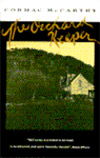
After college, Cormac went to Chicago, where he worked as an auto mechanic while writing his first novel, The Orchard Keeper.
The Orchard Keeper was published by Random House in 1965. Cormac's editor there was Albert Erskine, William Faulkner's longtime editor. The Orchard Keeper is set in a small, remote community in rural Tennessee in the years between the two world wars. It tells of John Wesley Rattner, a young boy, and Marion Sylder, an outlaw and bootlegger who, unbeknownst to either of them, has killed the boy's father. Together with Rattner's uncle Ather, who belongs to a former age in his communion with nature and his stoic independence, they enact a drama that seems born of the land itself. All three are heroes of an intense and compelling celebration of values lost to time and industrialization.
Before publication, Cormac received a traveling fellowship from the American Academy of Arts and Letters, which he used to travel to Ireland. In 1966, he also received the Rockefeller Foundation Grant, with which he continued to tour Europe, settling on the island of Ibiza.
The Orchard Keeper was published by Random House in 1965. Cormac's editor there was Albert Erskine, William Faulkner's longtime editor. The Orchard Keeper is set in a small, remote community in rural Tennessee in the years between the two world wars. It tells of John Wesley Rattner, a young boy, and Marion Sylder, an outlaw and bootlegger who, unbeknownst to either of them, has killed the boy's father. Together with Rattner's uncle Ather, who belongs to a former age in his communion with nature and his stoic independence, they enact a drama that seems born of the land itself. All three are heroes of an intense and compelling celebration of values lost to time and industrialization.
Before publication, Cormac received a traveling fellowship from the American Academy of Arts and Letters, which he used to travel to Ireland. In 1966, he also received the Rockefeller Foundation Grant, with which he continued to tour Europe, settling on the island of Ibiza.
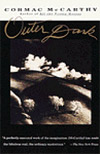
While in Ibiza, Cormac completed revisions of his next novel, Outer Dark. In 1967, he returned to the United States and moved to Tennessee. Outer Dark was published by Random House in 1968.
Outer Dark is a starkly evocative novel set in an unspecified place in Appalachia, sometime around the turn of the century. A woman bears her brother's child, a boy. He leaves the baby in the woods and tells her he died of natural causes. Discovering her brother's lie, she sets forth alone to find her son. Both brother and sister wander separately through a countryside being scourged by three terrifying and elusive strangers, headlong toward an eerie, apocalyptic resolution.
Outer Dark is a starkly evocative novel set in an unspecified place in Appalachia, sometime around the turn of the century. A woman bears her brother's child, a boy. He leaves the baby in the woods and tells her he died of natural causes. Discovering her brother's lie, she sets forth alone to find her son. Both brother and sister wander separately through a countryside being scourged by three terrifying and elusive strangers, headlong toward an eerie, apocalyptic resolution.
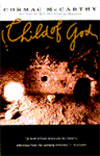
In 1969, Cormac received the Guggenheim Fellowship for Creative Writing. His next novel, Child of God, was published in 1973.
In the taut, chilling novel, Lester Ballard—a violent, dispossessed man falsely accused of rape—haunts the hill country of East Tennessee when he is released from jail. While telling his story, Cormac depicts the most sordid aspects of life with dignity, humor and his characteristic lyrical brilliance.
In the taut, chilling novel, Lester Ballard—a violent, dispossessed man falsely accused of rape—haunts the hill country of East Tennessee when he is released from jail. While telling his story, Cormac depicts the most sordid aspects of life with dignity, humor and his characteristic lyrical brilliance.
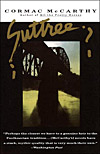
Cormac moved to Texas in the late 1970s and published his fourth novel, Suttree, in 1979. It is a book that had occupied his writing life on and off for 20 years.
Suttree is the story of Cornelius Suttree, who has forsaken a life of privilege to live in a dilapidated houseboat on the Tennessee River near Knoxville. Remaining on the margins of the outcast community there—a brilliantly imagined collection of eccentrics, criminals and squatters—he rises above the physical and human squalor with detachment, humor and dignity.
Suttree is the story of Cornelius Suttree, who has forsaken a life of privilege to live in a dilapidated houseboat on the Tennessee River near Knoxville. Remaining on the margins of the outcast community there—a brilliantly imagined collection of eccentrics, criminals and squatters—he rises above the physical and human squalor with detachment, humor and dignity.
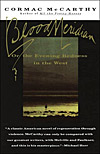
After receiving a MacArthur Fellowship in 1981, Cormac published his fifth novel, Blood Meridian, in 1985.
An epic novel of the violence and depravity that attended America's westward expansion, Blood Meridian brilliantly subverts the conventions of the Western novel and the mythology of the "wild west." Based on historical events that took place on the Texas-Mexico border in the 1850s, it traces the fortunes of the Kid, a 14-year-old Tennessean who stumbles into a nightmarish world where Indians are being murdered and the market for their scalps is thriving.
An epic novel of the violence and depravity that attended America's westward expansion, Blood Meridian brilliantly subverts the conventions of the Western novel and the mythology of the "wild west." Based on historical events that took place on the Texas-Mexico border in the 1850s, it traces the fortunes of the Kid, a 14-year-old Tennessean who stumbles into a nightmarish world where Indians are being murdered and the market for their scalps is thriving.
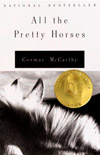
After the retirement of Albert Erskine, Cormac moved from Random House to Alfred A. Knopf. All the Pretty Horses, the first volume of The Border Trilogy, was published by Knopf in 1992, and it was later turned into a feature film starring Matt Damon and Penelope Cruz and directed by Billy Bob Thornton.
The national best-seller is the tale of John Grady Cole, who at 16 finds himself at the end of a long line of Texas ranchers, cut off from the only life he has ever imagined for himself. With two companions, he sets off for Mexico on a sometimes idyllic, sometimes comic journey to a place where dreams are paid for in blood. The book won the National Book Award for Fiction and the National Book Critics Circle Award.
The national best-seller is the tale of John Grady Cole, who at 16 finds himself at the end of a long line of Texas ranchers, cut off from the only life he has ever imagined for himself. With two companions, he sets off for Mexico on a sometimes idyllic, sometimes comic journey to a place where dreams are paid for in blood. The book won the National Book Award for Fiction and the National Book Critics Circle Award.
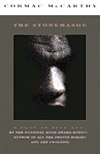
After the success of All the Pretty Horses, a play Cormac had written in the mid-1970s was revised and published by Ecco Press in 1994.
The Stonemason is a taut, expansively imagined drama about four generations of an African-American family.
Set in Louisville, Kentucky, in the 1970s, the Telfairs are stonemasons and have been for generations. Ben Telfair has given up his education to apprentice himself to his grandfather, Papaw, a man who knows that "true masonry is not held together by cement but...by the warp of the world." Out of the love that binds these two men and the gulf that separates them from the Telfairs who have forsaken—or dishonored—the family trade, the drama features precise observation of the physical world; language that has the bite of common speech and the force of Biblical prose.
The Stonemason is a taut, expansively imagined drama about four generations of an African-American family.
Set in Louisville, Kentucky, in the 1970s, the Telfairs are stonemasons and have been for generations. Ben Telfair has given up his education to apprentice himself to his grandfather, Papaw, a man who knows that "true masonry is not held together by cement but...by the warp of the world." Out of the love that binds these two men and the gulf that separates them from the Telfairs who have forsaken—or dishonored—the family trade, the drama features precise observation of the physical world; language that has the bite of common speech and the force of Biblical prose.

In 1994, Knopf also released the second volume of The Border Trilogy. In The Crossing, Cormac fulfills the promise of All the Pretty Horses, and at the same time, he gives readers a work that is darker and more visionary, a novel with the unstoppable momentum of a classic western and the elegiac power of a lost American myth.
In the late 1930s, 16-year-old Billy Parham captures a she-wolf that has been marauding his family's ranch. But instead of killing it, he decides to take it back to the mountains of Mexico. With that crossing, he begins an arduous and often dreamlike journey into a country where men meet ghosts and violence strikes as suddenly as heat lightning—a world where there is no order "save that which death has put there."
In the late 1930s, 16-year-old Billy Parham captures a she-wolf that has been marauding his family's ranch. But instead of killing it, he decides to take it back to the mountains of Mexico. With that crossing, he begins an arduous and often dreamlike journey into a country where men meet ghosts and violence strikes as suddenly as heat lightning—a world where there is no order "save that which death has put there."
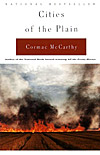
The third volume of The Border Triology, Cities of the Plain, was published in 1998. In it, Cormac fashions a darkly beautiful elegy for the American frontier.
The setting is New Mexico in 1952, where John Grady Cole and Billy Parham are working as ranch hands. To the north lie the proving grounds of Alamogordo; to the south, the twin cities of El Paso and Juarez, Mexico. Their life is made up of trail drives and horse auctions and stories told by campfire light. It is a life that is about to change forever, and John Grady and Billy both know it.
The catalyst for that change appears in the form of a beautiful, ill-starred Mexican prostitute. When John Grady falls in love, Billy agrees—against his better judgment—to help him rescue the girl from her suavely brutal pimp. The ensuing events resonate with the violence and inevitability of classic tragedy.
The setting is New Mexico in 1952, where John Grady Cole and Billy Parham are working as ranch hands. To the north lie the proving grounds of Alamogordo; to the south, the twin cities of El Paso and Juarez, Mexico. Their life is made up of trail drives and horse auctions and stories told by campfire light. It is a life that is about to change forever, and John Grady and Billy both know it.
The catalyst for that change appears in the form of a beautiful, ill-starred Mexican prostitute. When John Grady falls in love, Billy agrees—against his better judgment—to help him rescue the girl from her suavely brutal pimp. The ensuing events resonate with the violence and inevitability of classic tragedy.
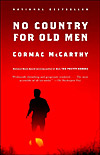
Cormac's next novel, No Country for Old Men, was published in 2005. In the blistering novel, Cormac returns to the Texas-Mexico border, the setting of his famed Border Trilogy. The time is our own, when rustlers have given way to drug runners and small towns have become free-fire zones.
One day, a good old boy named Llewellyn Moss finds a pickup truck surrounded by a bodyguard of dead men. A load of heroin and $2 million in cash are still in the back. When Moss takes the money, he sets off a chain reaction of catastrophic violence that not even the law—in the person of aging, disillusioned Sheriff Bell—can contain.
As Moss tries to evade his pursuers—in particular a mysterious mastermind who flips coins for human lives—Cormac simultaneously strips down the American crime novel and broadens its concerns to encompass themes as ancient as the Bible and as bloodily contemporary as this morning's headlines.
One day, a good old boy named Llewellyn Moss finds a pickup truck surrounded by a bodyguard of dead men. A load of heroin and $2 million in cash are still in the back. When Moss takes the money, he sets off a chain reaction of catastrophic violence that not even the law—in the person of aging, disillusioned Sheriff Bell—can contain.
As Moss tries to evade his pursuers—in particular a mysterious mastermind who flips coins for human lives—Cormac simultaneously strips down the American crime novel and broadens its concerns to encompass themes as ancient as the Bible and as bloodily contemporary as this morning's headlines.
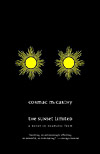
The Sunset Limited is a novel in dramatic form. It was originally performed by Steppenwolf Theatre Company of Chicago and published in paperback by Vintage Books in 2006.
In the novel, a startling encounter on a New York subway platform leads two strangers to a run-down tenement where a life or death decision must be made.
In that small apartment, "Black" and "White," as the two men are known, begin a conversation that leads each back through his own history, mining the origins of two fundamentally opposing world views. White is a professor whose seemingly enviable existence of relative ease has left him nonetheless in despair. Black, an ex-con and ex-addict, is the more hopeful of the men—though he is just as desperate to convince White of the power of faith as White is desperate to deny it. Their aim is no less than this: to discover the meaning of life.
Cormac's most recent novel, The Road, was originally published in hardcover by Knopf in 2006.
Read the synopsis of the author's Pulitzer Prize–winning novel.
In the novel, a startling encounter on a New York subway platform leads two strangers to a run-down tenement where a life or death decision must be made.
In that small apartment, "Black" and "White," as the two men are known, begin a conversation that leads each back through his own history, mining the origins of two fundamentally opposing world views. White is a professor whose seemingly enviable existence of relative ease has left him nonetheless in despair. Black, an ex-con and ex-addict, is the more hopeful of the men—though he is just as desperate to convince White of the power of faith as White is desperate to deny it. Their aim is no less than this: to discover the meaning of life.
Cormac's most recent novel, The Road, was originally published in hardcover by Knopf in 2006.
Read the synopsis of the author's Pulitzer Prize–winning novel.



